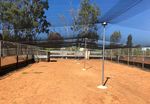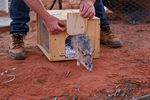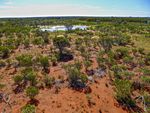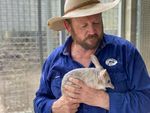Saving the Bilby, One Step at a Time - Australian Wildlife Society
←
→
Page content transcription
If your browser does not render page correctly, please read the page content below
Saving the
One Step at a Time
Bilby, Kevin Bradley
Bilbies have been an intrinsic part of increase the chances of survival of other The overall bilby population in the
the unique Australian landscape for a threatened species and countless wildlife wild has suffered a catastrophic
very long time, with fossilised remains that share the same habitats and face decline, primarily due to the
of their ancestors’ carbon-dated to be the same threatening processes. introduction of invasive predators
more than fifteen million years old. to Australia and changes in land
Before Europeans arrived in Australia, Bilbies Love to Dig management practices, including
greater bilbies (Macrotis lagotis) roamed They are one of nature’s ecosystem fire and intensive agriculture. Over
across 70 percent of Australia’s engineers and play an essential part in 80 percent of Australia’s remaining
mainland and stretched from the the restoration of soil and rejuvenation wild bilby populations occur on
Great Dividing Range in Queensland to of vegetation in arid Australia. Bilbies ‘Indigenous Protected Areas’.
Western Australia’s beaches. use their strong front paws to dig deep However, other bilbies are safe from
burrows that spiral down into the feral predators behind large predator
Yet, in the last one hundred years, exclusion fences or in captivity
ground for over two metres. In doing
they have been pushed to the brink for breeding to support a National
so, they facilitate water penetration
of extinction as a direct result of Recovery Plan for the species.
deep into the ground. In contrast,
colonisation and change of land Consequently, it is scarce for anyone
hard-hoofed animals that have been
use, population growth, and the ever to see a bilby in the wild.
introduced to Australia compact the soil
introduction of non-native species,
surface so when the rain comes, instead The greater bilby is a nocturnal,
particularly invasive predators such as
of soaking in, it runs straight across the omnivorous marsupial in the order
the European red fox (Vulpes vulpes) and
soil, causing erosion and disrupting the Peramelemophia (bandicoots). It is also
the feral cat (Cattus cattus).
balanced ecosystem of arid Australia. commonly referred to as a dalgyte,
The bilby is of significant cultural pinkie, or rabbit-eared bandicoot.
When bilbies feed, they scratch many
importance to Australia’s First Peoples Strictly speaking, they are not a
smaller holes in the soil (feed scrapes)
as a ‘creation animal’ present in their bandicoot; they are a family of their
that collect seed and plant material and own – Thylacomyidae.
Dreamtime stories, songs, and art –
water while aerating the soil to support
spanning across many Indigenous
seed germination. Bilbies essentially Bilbies, none-the-less, are the last of our
Nations and language groups across
create numerous compost pits and bandicoot line in arid Australia. There
Australia.
native market gardens every night, were thought to be six species in the
Bilbies are a ‘flagship’ species, meaning which is why bilbies are so crucial to our
that their protection is even more harsh but fragile arid environment and Above: Opal, the bilby, being released into
critical because their survival will the balance of our natural ecosystems. Currawinya Sanctuary.
36 Australian Wildlife Vol 2 - Autumn 2021early 1800s, but sadly the greater bilby is the only remaining one. The lesser bilby (Macrotis leucura) became extinct in the 1950s; the greater bilby survives but remains Endangered. Save the Bilby Fund is a small charity doing a mighty job to ensure that the bilby does not join the appalling list of thirty-four mammal species that Australia has lost forever. With just one full-time employee – the Chief Executive Officer, Kevin Bradley, aided by three part-time staff, Save the Bilby Fund plays a lead role in national recovery efforts for the species. Save the Bilby Fund was co-founded by the late scientist, Peter McRae, and the late Frank Manthey OAM – known fondly as ‘the bilby brothers’. Save the Bilby Fund launched in 1999 as a national appeal to build a predator exclusion fence on Currawinya National Park and re-establish bilbies after a seventy-year absence from the landscape. They chose Currawinya as having suitable habitat. It is close to the centre of the area where bilbies Save the Bilby Fund breeding facility. used to occur in eastern Australia and the last remnant wild populations in Far West Queensland, between Birdsville and Boulia. In March 2015, Save the Bilby Fund hosted the Greater Bilby Recovery Summit. It brought together thirty- nine experts who represented twenty- nine stakeholder groups involved in bilby conservation nationally. These groups openly discussed the challenges to bilby recovery and forged a consensus on a plan for this species’ future in the Australian landscape. The event was an initiative of Save the Bilby Fund, in partnership with the Queensland Department of Environment and Heritage Protection, the Taronga Conservation Society Australia, Dreamworld Wildlife Foundation, and the Australian Government Department of the Environment. The workshop was designed and facilitated by the International Union for Conservation of Nature and Species Survival Commission Conservation Breeding Specialist Group. Since the Greater Bilby Recovery Summit in 2015, Save the Bilby Fund Chief Executive Officer, Kevin Bradley, has been the Greater Bilby National Recovery Team’s chair. Kevin works with stakeholders from all over Australia, and members include Indigenous ranger groups, state and federal government agencies, non-governmental organisations, landholders and Bilbies love to dig. Australian Wildlife Vol 2 - Autumn 2021 37
Inside the bilby fence at Currawinya Sanctuary. Kevin Bradley, Chief Executive Officer of Save the Bilby Fund.
managers, researchers, and participants of the Australasian years. Save the Bilby Fund are working to understand and
Species Management Program that assist with a nationally protect Australia’s few remaining wild bilby populations
coordinated breeding program. facing increasing threats. Managing threatening processes to
establish bilbies back to areas where they have disappeared
Save the Bilby Fund is committed to delivering on the
remains an important focus for Save the Bilby Fund.
Greater Bilby Recovery Summit 2015 Report and Interim
Conservation Plan. Save the Bilby Fund is working with In the last three years, the predator exclusion fence at
all stakeholders to develop a new Greater Bilby National Currawinya Sanctuary has been significantly upgraded.
Recovery Plan that has been based on the essential outcomes Consequently, Save the Bilby Fund has had the joy of
of the Summit. It is a tremendous task that Save the Bilby welcoming forty-six newborn bilbies in its breeding facility in
Fund cannot do alone. Charleville and has released twenty-six bilbies into the fenced
sanctuary to live freely.
Save the Bilby Fund receives no current government funding
and must fundraise from the public to complete every single Save the Bilby Fund is working with PhD Candidate Cass
step towards achieving its immediate (and attainable) goals. Arkinstall from the University of Queensland, who is
Save the Bilby Fund aim to create a safe population of four researching and monitoring the health and movements of
hundred bilbies at Currawinya Sanctuary and 10,000 bilbies re-introduced bilbies at the sanctuary. Save the Bilby Fund
across Australia to provide appropriate genetic insurance believe that it is safe to say that there may be over one
against extinction in the wild for the next one hundred hundred bilbies at Currawinya Sanctuary already.
Bilby (Macrotis lagotis) tracks. PhD student, Cass Arkinstall, measuring bilby tracks.
38 Australian Wildlife Vol 2 - Autumn 2021Support Bilby Conservation
Save the Bilby Fund relies on everyday
Australians who want to save the
bilby from extinction and can afford
to make a financial contribution.
Small or large, every little bit helps,
and they are incredibly grateful for
everyone who has supported the
project so far.
There is still a tremendous amount
of work ahead. Save the Bilby Fund
need to re-survey the last remaining
wild bilby population between
Birdsville and Boulia that has not been
extensively surveyed since the late
1990s when Peter McRae undertook
the work. They also need to manage
threats to the bilbies beyond the fence
at Currawinya Sanctuary. Generating
ongoing funding and support is critical Excavation of the bilby creche.
to saving the bilby and Save the Bilby
Fund’s vital work.
Please help ensure our children and
grandchildren can continue to have
bilbies in their world and that we do
not lose these precious battlers of the
outback on our watch. All donations
greater than $2 are tax-deductible. If you
would like to donate, you can easily do
so via the Save the Bilby Fund website
www.savethebilbyfund.org
Key outcome and impact of the
funding provided: Save the Bilby
Fund have been able to upgrade
their bilby captive breeding facilities,
built new crèche-ing pens, and make
enclosure improvements, including
new feral-proof fencing. Save the
Bilby Fund has already witnessed
several births, with more on the way!
Great news for the conservation of
this species.
A completed bilby pen.
Kinder Natoons sponsorship helps save Australia’s
threatened native wildlife
The Australian Wildlife Society
continued its significant sponsorship
program with family-owned ®
confectionery brand, Ferrero,
for a second year.
Ferrero’s Kinder brand created the
Kinder Natoons collection which
aims to help families play, learn,
and protect endangered wildlife
across Australia and around the
world. Kinder’s support has helped
five wildlife conservation initiatives
in 2020, including Save the Bilby
Fund.
Australian Wildlife Vol 2 - Autumn 2021 39You can also read



























































